从 RNN 开始, CS231n 的 Lecture Notes 就没有了, 因此我根据上课时的 Slides 整理了一些需要重视的知识点. 还可以参考这些文章或是视频来加深理解。
Lecture 10
Introduction
Recurrent Networks offer a lot of flexibility:

- one to one: Vanilla Neural Networks
- one to many: e.g. Image Captioning (image -> sequence of words)
- many to one: e.g. Sentiment Classification (sequence of words -> sentiment)
- many to many:
- e.g. Machine Translation (seq of words -> seq of words)
- e.g. Video classification on frame level
RNN can also do sequential precessing of fix inputs (Multiple Object Recognition with Visual Attention, Ba et al.) or fixed outputs (DRAW: A Recurrent Neural Network For Image Generation, Gregor et al.).
Recurrent Neural Network
Concept
Usually we want to predict a vector at some time steps. To achieve this goal, we can process a sequence of vectors $x$ by applying a recurrence formula at every time step:
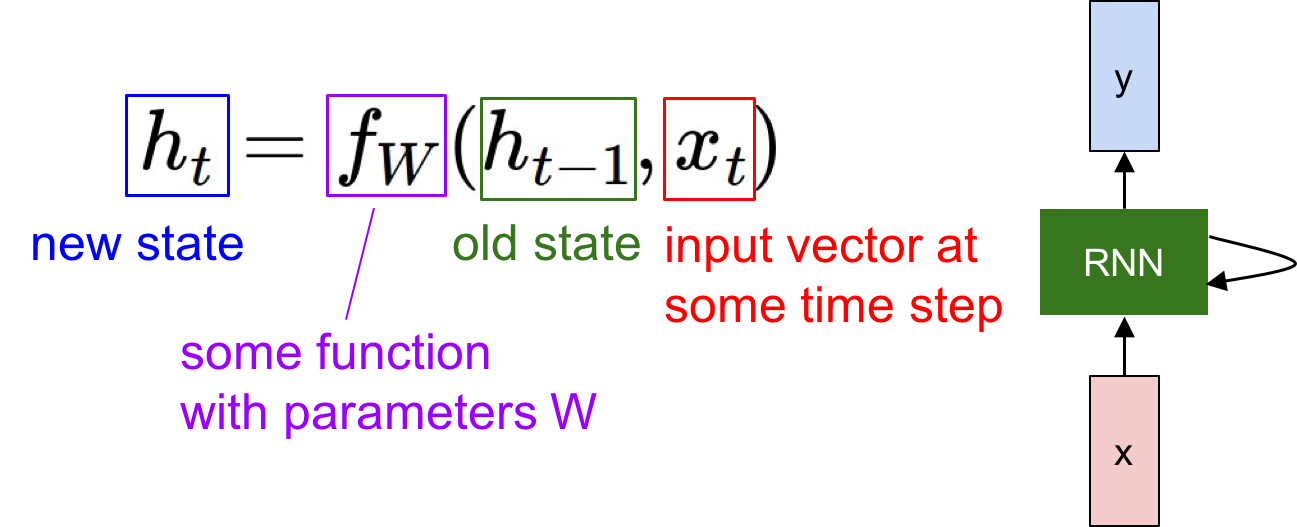
Notice: the same function and the same set of parameters are used at every time step. That’s to say, we use shared weights.
(Vanilla) Recurrent Neural Network
The state consists of a single “hidden” vector $h$:
- $h_t = tanh (W_{hh} h_{t-1} + W_{xh} x_t)$
- $y_t = W_{hy} h_t$
Example: Character-level language model
We have a vocabulary of four characters $\begin{bmatrix} h & e & l & o \end{bmatrix}$, and the example training sequence is “hello”.
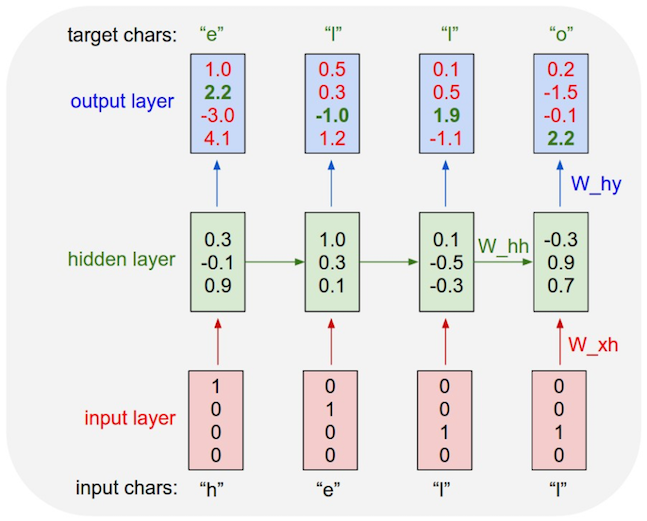
And we can look its the implement.
Data I/O
1
2
3
4
5
6
7
8
9
10
11
12
13
|
"""
Minimal character-level Vanilla RNN model. Written by Andrej Karpathy (@karpathy)
BSD License
"""
import numpy as np
# data I/O
data = open('input.txt', 'r').read() # should be simple plain text file
chars = list(set(data))
data_size, vocab_size = len(data), len(chars)
print 'data has %d characters, %d unique.' % (data_size, vocab_size)
char_to_ix = { ch:i for i,ch in enumerate(chars) }
ix_to_char = { i:ch for i,ch in enumerate(chars) }
|
Initializations
1
2
3
4
5
6
7
8
9
10
11
|
# hyperparameters
hidden_size = 100 # size of hidden layer of neurons
seq_length = 25 # number of steps to unroll the RNN for
learning_rate = 1e-1
# model parameters
Wxh = np.random.randn(hidden_size, vocab_size)*0.01 # input to hidden
Whh = np.random.randn(hidden_size, hidden_size)*0.01 # hidden to hidden
Why = np.random.randn(vocab_size, hidden_size)*0.01 # hidden to output
bh = np.zeros((hidden_size, 1)) # hidden bias
by = np.zeros((vocab_size, 1)) # output bias
|
Main Loop
1
2
3
4
5
6
7
8
9
10
11
12
13
14
15
16
17
18
19
20
21
22
23
24
25
26
27
28
29
30
31
32
|
n, p = 0, 0
mWxh, mWhh, mWhy = np.zeros_like(Wxh), np.zeros_like(Whh), np.zeros_like(Why)
mbh, mby = np.zeros_like(bh), np.zeros_like(by) # memory variables for Adagrad
smooth_loss = -np.log(1.0/vocab_size)*seq_length # loss at iteration 0
while True:
# prepare inputs (we're sweeping from left to right in steps seq_length long)
if p+seq_length+1 >= len(data) or n == 0:
hprev = np.zeros((hidden_size,1)) # reset RNN memory
p = 0 # go from start of data
inputs = [char_to_ix[ch] for ch in data[p:p+seq_length]]
targets = [char_to_ix[ch] for ch in data[p+1:p+seq_length+1]]
# sample from the model now and then
if n % 100 == 0:
sample_ix = sample(hprev, inputs[0], 200)
txt = ''.join(ix_to_char[ix] for ix in sample_ix)
print '----\n %s \n----' % (txt, )
# forward seq_length characters through the net and fetch gradient
loss, dWxh, dWhh, dWhy, dbh, dby, hprev = lossFun(inputs, targets, hprev)
smooth_loss = smooth_loss * 0.999 + loss * 0.001
if n % 100 == 0: print 'iter %d, loss: %f' % (n, smooth_loss) # print progress
# perform parameter update with Adagrad
for param, dparam, mem in zip([Wxh, Whh, Why, bh, by],
[dWxh, dWhh, dWhy, dbh, dby],
[mWxh, mWhh, mWhy, mbh, mby]):
mem += dparam * dparam
param += -learning_rate * dparam / np.sqrt(mem + 1e-8) # adagrad update
p += seq_length # move data pointer
n += 1 # iteration counter
|
Loss function
- forward pass (compute loss)
- backward pass (compute param gradient)
1
2
3
4
5
6
7
8
9
10
11
12
13
14
15
16
17
18
19
20
21
22
23
24
25
26
27
28
29
30
31
32
33
34
35
|
def lossFun(inputs, targets, hprev):
"""
inputs,targets are both list of integers.
hprev is Hx1 array of initial hidden state
returns the loss, gradients on model parameters, and last hidden state
"""
xs, hs, ys, ps = {}, {}, {}, {}
hs[-1] = np.copy(hprev)
loss = 0
# forward pass
for t in xrange(len(inputs)):
xs[t] = np.zeros((vocab_size,1)) # encode in 1-of-k representation
xs[t][inputs[t]] = 1
hs[t] = np.tanh(np.dot(Wxh, xs[t]) + np.dot(Whh, hs[t-1]) + bh) # hidden state
ys[t] = np.dot(Why, hs[t]) + by # unnormalized log probabilities for next chars
ps[t] = np.exp(ys[t]) / np.sum(np.exp(ys[t])) # probabilities for next chars
loss += -np.log(ps[t][targets[t],0]) # softmax (cross-entropy loss)
# backward pass: compute gradients going backwards
dWxh, dWhh, dWhy = np.zeros_like(Wxh), np.zeros_like(Whh), np.zeros_like(Why)
dbh, dby = np.zeros_like(bh), np.zeros_like(by)
dhnext = np.zeros_like(hs[0])
for t in reversed(xrange(len(inputs))):
dy = np.copy(ps[t])
dy[targets[t]] -= 1 # backprop into y. see http://cs231n.github.io/neural-networks-case-study/#grad if confused here
dWhy += np.dot(dy, hs[t].T)
dby += dy
dh = np.dot(Why.T, dy) + dhnext # backprop into h
dhraw = (1 - hs[t] * hs[t]) * dh # backprop through tanh nonlinearity
dbh += dhraw
dWxh += np.dot(dhraw, xs[t].T)
dWhh += np.dot(dhraw, hs[t-1].T)
dhnext = np.dot(Whh.T, dhraw)
for dparam in [dWxh, dWhh, dWhy, dbh, dby]:
np.clip(dparam, -5, 5, out=dparam) # clip to mitigate exploding gradients
return loss, dWxh, dWhh, dWhy, dbh, dby, hs[len(inputs)-1]
|
Sampling
1
2
3
4
5
6
7
8
9
10
11
12
13
14
15
16
17
|
def sample(h, seed_ix, n):
"""
sample a sequence of integers from the model
h is memory state, seed_ix is seed letter for first time step
"""
x = np.zeros((vocab_size, 1))
x[seed_ix] = 1
ixes = []
for t in xrange(n):
h = np.tanh(np.dot(Wxh, x) + np.dot(Whh, h) + bh)
y = np.dot(Why, h) + by
p = np.exp(y) / np.sum(np.exp(y))
ix = np.random.choice(range(vocab_size), p=p.ravel())
x = np.zeros((vocab_size, 1))
x[ix] = 1
ixes.append(ix)
return ixes
|
Gradient Check
1
2
3
4
5
6
7
8
9
10
11
12
13
14
15
16
17
18
19
20
21
22
23
24
25
26
|
# gradient checking
from random import uniform
def gradCheck(inputs, target, hprev):
global Wxh, Whh, Why, bh, by
num_checks, delta = 10, 1e-5
_, dWxh, dWhh, dWhy, dbh, dby, _ = lossFun(inputs, targets, hprev)
for param,dparam,name in zip([Wxh, Whh, Why, bh, by], [dWxh, dWhh, dWhy, dbh, dby], ['Wxh', 'Whh', 'Why', 'bh', 'by']):
s0 = dparam.shape
s1 = param.shape
assert s0 == s1, 'Error dims dont match: %s and %s.' % (`s0`, `s1`)
print name
for i in xrange(num_checks):
ri = int(uniform(0,param.size))
# evaluate cost at [x + delta] and [x - delta]
old_val = param.flat[ri]
param.flat[ri] = old_val + delta
cg0, _, _, _, _, _, _ = lossFun(inputs, targets, hprev)
param.flat[ri] = old_val - delta
cg1, _, _, _, _, _, _ = lossFun(inputs, targets, hprev)
param.flat[ri] = old_val # reset old value for this parameter
# fetch both numerical and analytic gradient
grad_analytic = dparam.flat[ri]
grad_numerical = (cg0 - cg1) / ( 2 * delta )
rel_error = abs(grad_analytic - grad_numerical) / abs(grad_numerical + grad_analytic)
print '%f, %f => %e ' % (grad_numerical, grad_analytic, rel_error)
# rel_error should be on order of 1e-7 or less
|
Results
Using Shakespeare’s sonnet as input:
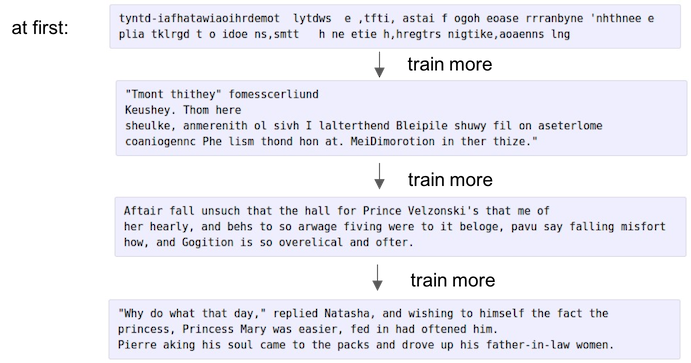
Example: Image Captioning
We use CNN to recognize objects and use RNN to generate captions.
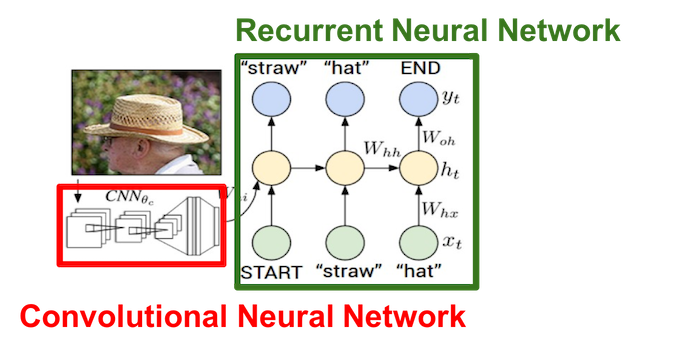
Cut the last two layers from CNN and connect it to RNN:
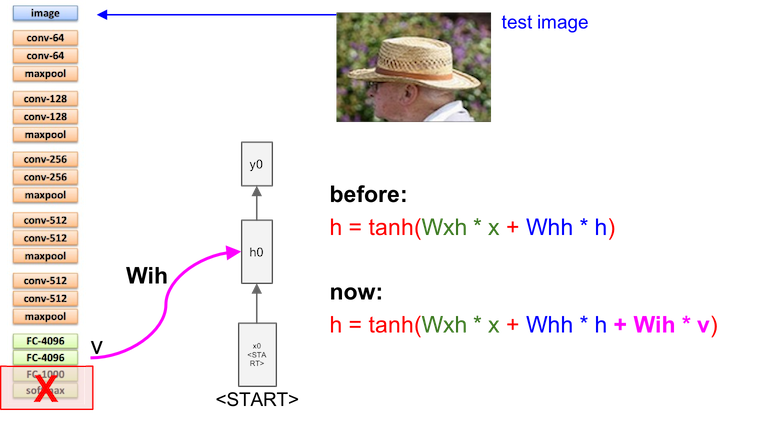
And smaple the output from previous layer to next layer as input:
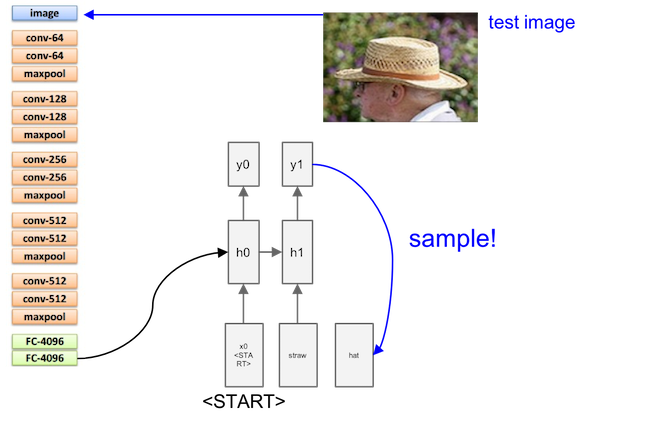
Sampling is stoped when meeting an END
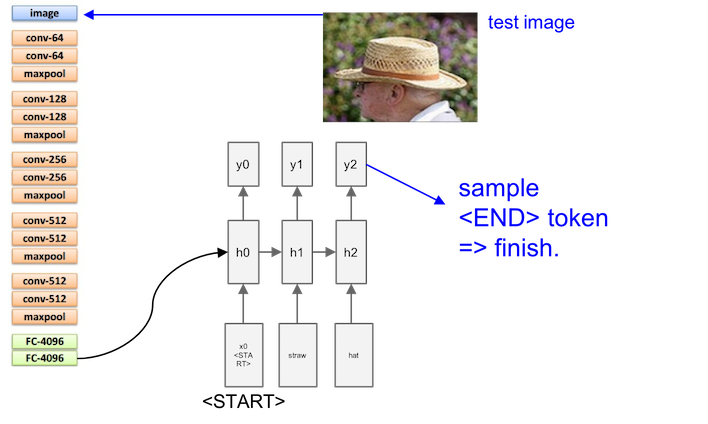
Finally, we’ll get a complete sentence (using Microsoft COCO dataset). The first row are good, but the second row may be not satisfactory.
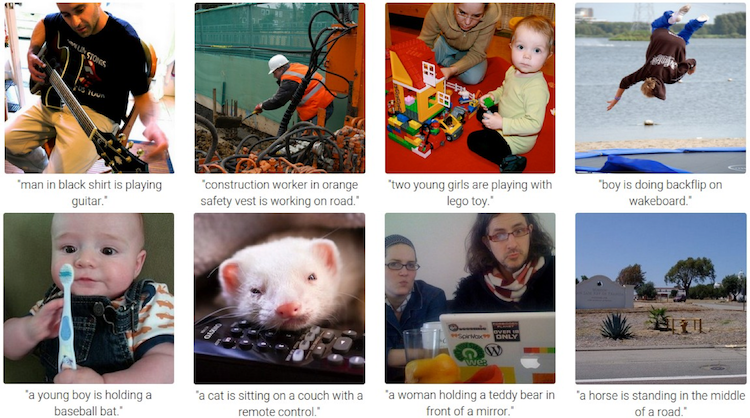
Reference:
- Explain Images with Multimodal Recurrent Neural Networks, Mao et al.
- Deep Visual-Semantic Alignments for Generating Image Descriptions, Karpathy and Fei-Fei
- Show and Tell: A Neural Image Caption Generator, Vinyals et al.
- Long-term Recurrent Convolutional Networks for Visual Recognition andDescription, Donahue et al.
- Learning a Recurrent Visual Representation for Image CaptionGeneration, Chen and Zitnick
More examples
We can also use RNN to generate open source textbooks written in LaTex, or generate C code from Linux source code, or searching for interpretable cells.
Long Short Term Memory (LSTM)
Vanishing/Exploding gradients
- Exploding gradients
- Truncated BPTT
- Clip gradients at threshold (something like anti-windup in control science LOL)
- RMSProp to adjust learning rate
- Vanishing gradients
- Harder to detect
- Weight Initialization
- ReLU activation functions
- RMSProp
- LSTM, GRUs (<– That’s why we use LSTM)
Introduction
LSTM is proposed in [Hochreiter et al., 1997]. GRU is a knid of simplified LSTM.
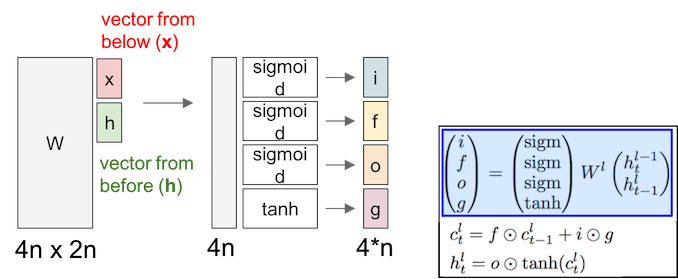
ResNet is to PlainNet what LSTM is to RNN, kind of.

Concept
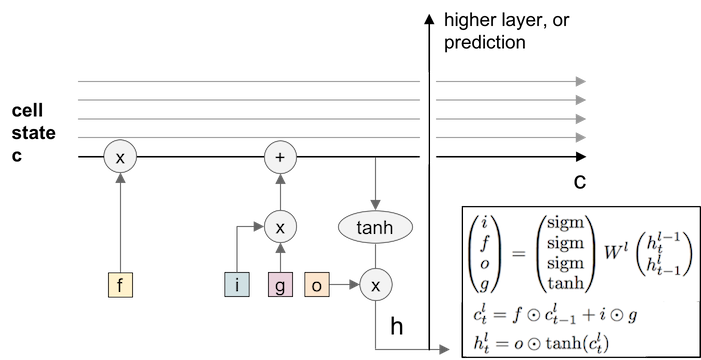
LSTM have two states, one is cell state ($c$), another is hidden state ($h$):
- $i$: input gate, “add to memory”, decides whether do we want to add value to this cell.
- $f$: forget gate, “flush the memory”, decides whether to shut off the cell and reset the counter.
- $o$: output gate, “get from memory”, decides how much do we want to get from this cell.
- $g$: input, decides how much do we want to add to this cell.
Summary
- RNNs allow a lot of flexibility inarchitecture design
- Vanilla RNNs are simple but don’twork very well
- Common to use LSTM or GRU: theiradditive interactions improve gradient flow
- Backward flow of gradients in RNNcan explode or vanish. Exploding is controlled with gradient clipping.Vanishing is controlled with additive interactions (LSTM)
- Better/simpler architectures are ahot topic of current research
- Better understanding (boththeoretical and empirical) is needed.
(To be improved by adding extra materials…)
References











